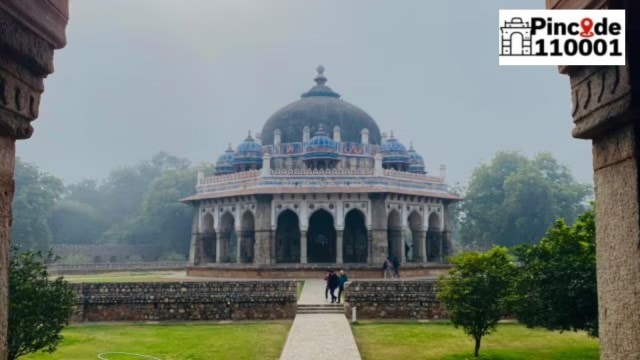Isa Khan Niyazi’s tomb: Among the first and last structures of its kind
The octagonal structure with glimpses of blue tiles adorning its domes can be accessed following a short walk from the complex main gates, towards the right where a nondescript entrance gives no indication to the fascinating, exquisite structure to be found inside.
 A nondescript entrance leads visitors to the exquisite monument. (Photo Credit: Mustafa Naqvi/Delhi Karavan)
A nondescript entrance leads visitors to the exquisite monument. (Photo Credit: Mustafa Naqvi/Delhi Karavan)On a visit to the majestic Humayun’s Tomb, it is easy to miss the countless big and small, in-ruins and well-preserved monuments in the complex. But for the ardent explorer, the premises can throw up many gems – one of them is the tomb of Isa Khan Niyazi, which even precedes the monument that the complex is best known for by several years.
The octagonal structure with glimpses of blue tiles adorning its domes can be accessed following a short walk from the complex main gates, towards the right where a nondescript entrance gives no indication to the fascinating, exquisite structure to be found inside.
“Niyazi was an Afghan who was one of the most important nobles of Sher Shah Sur, and his successor Islam Shah Sur. He built this tomb within his lifetime in 1547-48, and intended it to be a sort of a family mausoleum as there are several graves within it… all uninscribed,” writes historian and author Swapna Liddle in her book 14 Historic Walks of Delhi.
According to author and filmmaker Sohail Hashmi, the tomb is among the last of the Pathan structures built in Delhi. “Of the series of monuments in this area (such as Rahim’s Tomb, Humayun’s Tomb, and all the mausoleums in Sundar Nursery), this is also the first to be built. All these monuments were built in this part of Delhi due to the proximity to the shrine of Sufi Saint Hazrat Nizamuddin Auliya. Because it was believed that wherever a great Sufi is buried, the land becomes holy. Getting buried there is said to increase your chances of going to heaven. The way you go to Benares to die…” he tells The Indian Express. On the architecture of the tomb, he says, “It borrows heavily from Lodhi architecture, which, for its part, borrowed from Tughlaq era architecture. Notice that the walls of the tomb appear to be leaning away from you. This is the Tughlaq style, which the Lodhis copied, and the tradition continued in Suri’s reign.”
Hashmi is referring to the tapering style of the tomb in which the foundation is broader than the upper part — something that is evident in tomb of Ghiyasuddin Tughlaq in Tughlaqabad, constructed in the 14th century.
“This gives one an impression that the monument is sprouting from the ground,” says Hashmi.
Niyazi’s tomb is largely made of Delhi quartzite, a popular building stone of the time found in the Aravallis. “Quartzite is very hard, a metamorphic rock with large grains that can’t be carved. This is why architecture in the Sultanate period seems lumpy, marked by thick pillars, far removed from delicate structures made of sandstone and marble during the Mughal period,” says Hashmi. Still, the tomb has glimpses of exquisiteness in the form of blue tiles and carvings on its façade, not to mention the intricate design on the inside of its dome.
“This was made possible by incised plasterwork over the stones. The plaster was made of limestone and crushed bricks. This plaster takes a year to dry. In the period when the plaster has not dried yet but begun to settle, you carry out the carving work and insert the glazed tiles. Again, this is the last of the monuments using this style because then comes the Humayun’s Tomb which is architecturally totally different,” says Hashmi.
Another interesting aspect of Niyazi’s tomb is the corbel arches, inserted inside true arches, he adds.
Liddle writes: “Notice how the carved corbels of grey quartzite frame the top of the doorway. This is a hangover from the typical architecture of the pre-Delhi Sultanate period when Indian builders spanned space using techniques based on horizontal beams placed on vertical columns.” This was because the mason till now had not started to trust the true arch, which became a fixture in monuments that came later, says Hashmi.
The tomb is relatively well preserved, albeit unevenly so, with some parts painted over and thus standing out and others left bare. “This is the result of a compromise between the style of preservation of the Archaeological Survey of India and the Aga Khan Trust (which works towards preservation of such cultural heritage). The main entry, and the chhatris on top, have been fully restored in the way they would have looked when they were built, this is the Aga Khan touch. The other seven faces have been preserved according to ASI’s brief that the monument be preserved in the condition it was found in,” says Hashmi.







